The octopus is an amazing creature, the most intelligent and agile of all invertebrates. A look at new research on how they keep track of their eight arms.
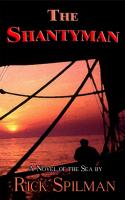 Yesterday we posted an interview by George Jepson from the May/June issue of the McBooks Press newsletter “Quarterdeck.” Here is Jepson’s review of my latest novel “The Shantyman” from the same issue.
Yesterday we posted an interview by George Jepson from the May/June issue of the McBooks Press newsletter “Quarterdeck.” Here is Jepson’s review of my latest novel “The Shantyman” from the same issue.
The Shantyman by Rick Spilman
George Anderson, retired from a lifetime at sea, recalls a voyage from New York to Australia and back in 1870 in the wooden Kennebec-built clipper Alhambra. Anderson was barely seventeen when he signed aboard as an A.B. or able seaman (able to hand, reef and steer).
In honor of the 250th anniversary of the launching of HMS Victory, here is a rolling broadside, fired by none other than HMS Victory. The ship is beginning a £50million restoration project in an attempt to preserve Nelson’s flagship for future generations. For an excellent look at the ship’s history check out Julian Stockwin’s VICTORY TURNS 250 in the May/June issue of Quarterdeck by McBooks Press.
Iran is reporting that it has released the container ship Maersk Tigris. The ship had been seized on April 28th as it transited the Strait of Hormuz. Neither Maersk Line, which is the ship’s charterer, nor Rickmers Shipmanagement, which manages the ship, could confirm the ship’s release. Iran had claimed that the ship was seized related to a decade’s old commercial dispute.
 I am very pleased to have been interviewed by George Jepson in the May/June issue of the McBooks Press‘ newsletter “Quarterdeck.” If you haven’t run across “Quarterdeck” you should take a look. (A subscription is free.) This issue includes my interview and a review of my novel The Shantyman as well as an article, Victory Turns 250, by Julian Stockwin. It also includes news of nautical fiction by James L. Nelson, J. D. Davies, Jan Needle, Steve Harrison, John Cahill, Joseph Heywood, and David Gilman, among others. Definitely worth taking a look.
I am very pleased to have been interviewed by George Jepson in the May/June issue of the McBooks Press‘ newsletter “Quarterdeck.” If you haven’t run across “Quarterdeck” you should take a look. (A subscription is free.) This issue includes my interview and a review of my novel The Shantyman as well as an article, Victory Turns 250, by Julian Stockwin. It also includes news of nautical fiction by James L. Nelson, J. D. Davies, Jan Needle, Steve Harrison, John Cahill, Joseph Heywood, and David Gilman, among others. Definitely worth taking a look.
Rick Spilman by George Jepson (reposted with permission.)
Rick Spilman resides in a lovely late nineteenth century brownstone on a tree-lined street in Jersey City, New Jersey, just across the Hudson River from Lower Manhattan.
During the period when Spilman’s home was constructed, New York Harbor teemed with sailing and steam vessels from around the world. By the early 1870s, the prows and bowsprits of the clippers were common sights along piers in the East River, the area known as South Street Seaport.
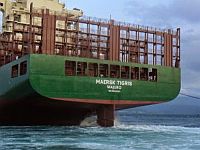 Does Iran have any conceivable case for seizing the Maersk Tigris? The short answer is “no.” The slightly longer answer might be “absolutely not” or “under no circumstances.”
Does Iran have any conceivable case for seizing the Maersk Tigris? The short answer is “no.” The slightly longer answer might be “absolutely not” or “under no circumstances.”
Iran is claiming a decade old cargo dispute as the basis for seizing the ship. Admiralty law does allow a nation to arrest a foreign ship for maritime liens resulting from the sort of cargo dispute existing between Maersk and an Iranian shipper. So far so good. The problem is that the arrest of the ship in “innocent transit” is generally not allowed. The ship needs to be in port. More than that, the ship arrested has to be the ship against which the claim was filed. The Maersk Tigris was not that ship. Iran cannot simply go after any ship operated by Maersk.
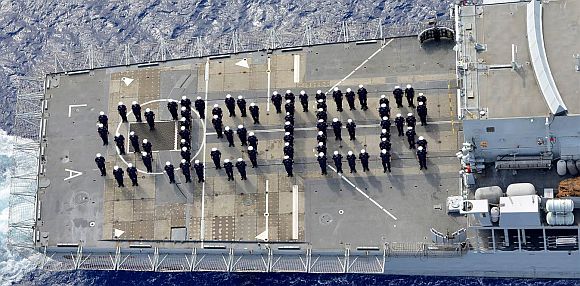
Sailors stand on the flight deck of the HMS Lancaster, known as the “Queen’s Frigate,” in a special congratulatory message to Prince George, passing on the news that he now has a sister.
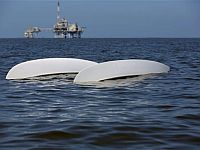
(Photo: Sharon Steinmann/AP
A week ago, tragedy struck at the Dauphin Island Regatta on Mobile Bay, when a powerful squall packing winds of almost 70 knots struck the assembled fleet. Six sailors were lost. The bodies of five sailors have been found. The Coast Guard has now suspended the search for the sixth sailor who is still missing and presumed dead. Officials said the Coast Guard has spent more than 180 hours searching more than 9,527 miles of water and 164 miles of shoreline.
The Coast Guard and the Alabama Law Enforcement Agency are conducting a joint investigation into the circumstances surrounding the events in Mobile Bay on Saturday during the Dauphin Island Regatta.
On April 20th, the 105′ trimaran Lending Club 2 sailed from Newport, Rhode Island to Bermuda in an amazing 23 hours, 9 minutes and 52 seconds, beating the previous record by a 15 hours. Lending Club 2 sailed the 635-nautical mile passage at an average speed of 27 knots. Here is a video about the record breaking voyage.
 Once again, May 2nd is International Scurvy Awareness Day! The festivities appear to be sponsored by a group calling itself Lime Strong. I am not sure whether this is an individual or a marketing arm for lime growers. Nevertheless, there is nothing wrong with awareness. Squeeze some extra lime juice in your rum today. Thanks to Bob McKane for the heads up.
Once again, May 2nd is International Scurvy Awareness Day! The festivities appear to be sponsored by a group calling itself Lime Strong. I am not sure whether this is an individual or a marketing arm for lime growers. Nevertheless, there is nothing wrong with awareness. Squeeze some extra lime juice in your rum today. Thanks to Bob McKane for the heads up.
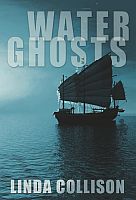 I am very excited about Linda Collison‘s new book, Water Ghosts. Coming soon from Old Salt Press. A teenaged boy on a summer adventure sailing aboard a traditional Chinese junk, believes the ship to be controlled by ghosts from the Ming Dynasty, and sailing to its doom.
I am very excited about Linda Collison‘s new book, Water Ghosts. Coming soon from Old Salt Press. A teenaged boy on a summer adventure sailing aboard a traditional Chinese junk, believes the ship to be controlled by ghosts from the Ming Dynasty, and sailing to its doom.
I see things other people don’t see
I hear things other people don’t hear
Fifteen-year-old James McCafferty is an unwilling sailor aboard a traditional Chinese junk, operated as adventure-therapy for troubled teens. Once at sea, the ship is gradually taken over by the spirits of courtiers who fled the Imperial court during the Ming Dynasty, more than 600 years ago. One particular ghost wants what James has and is intent on trading places with him. But the teens themselves are their own worst enemies in the struggle for life in the middle of the Pacific Ocean. A psychological story set at sea, with historical and paranormal elements.

Angelika Graswald, with fiance Vincent Viafore
At first, it sounded like a tragic story with a very predictable moral. A 46 year old male kayaker capsized, while not wearing a lifejacket, and was believed to have drowned. His 36 year old female paddling partner, who was wearing a life jacket, also ended up in the water, but survived. The moral of the story — always wear a life jacket. While part of this account may be accurate, it now appears that the tale is darker and more disturbing. Angelika Graswald, the female kayaker, has been charged with 2nd degree murder in the death of Vincent Viafore, her fiancé and fellow kayaker.
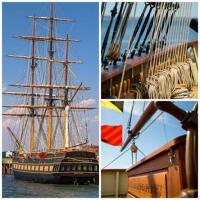 Sailing School Vessel (SSV) Oliver Hazard Perry will be docking at her new permanent berth this Saturday at Fort Adams State Park in Newport, RI. She is the first ocean-going full-rigged ship built in America in over a century. She will be available for viewing Tuesday afternoon, May 5 through May 12 and will be hosting public tours Saturday, May 9th through Monday, May 11th (9 a.m. – 5 p.m.) and on Tues, May 12th (9 a.m. – 3 p.m.)
Sailing School Vessel (SSV) Oliver Hazard Perry will be docking at her new permanent berth this Saturday at Fort Adams State Park in Newport, RI. She is the first ocean-going full-rigged ship built in America in over a century. She will be available for viewing Tuesday afternoon, May 5 through May 12 and will be hosting public tours Saturday, May 9th through Monday, May 11th (9 a.m. – 5 p.m.) and on Tues, May 12th (9 a.m. – 3 p.m.)
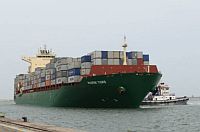 Yesterday, we posted about the Maersk Tigris, a 5470-TEU container ship, which was detained by boats from the Iranian Revolutionary Guard. Here is what we know so far.
Yesterday, we posted about the Maersk Tigris, a 5470-TEU container ship, which was detained by boats from the Iranian Revolutionary Guard. Here is what we know so far.
1. Is the Maersk Tigris a “U.S. cargo ship?”
No. Initially, Saudi owned Al-Arabiya and several Iranian new sources reported that the ship was a “U.S. cargo ship.” Nevertheless, the Maersk Tigris is owned by a Danish shipping company, is registered in the Marshal Islands and has no US citizens aboard. Oddly, boats from the Iranian Revolutionary Guard did intercept a US flag container ship, Maersk Kensington, last Friday, but did not detain the ship.
 The Marshall Island flagged container ship Maersk Tigris sailing from the Saudi port of Jeddah, bound for the United Arab Emirates port of Jebel Ali, was intercepted by Iranian forces in the Strait of Hormuz. As reported by Bloomberg, the ship was on an “internationally recognized maritime route” when it was intercepted by the Iran’s Islamic Revolutionary Guard Corps naval force, State Department spokesman Jeff Rathke told reporters in Washington. Cor Radings, an external spokesman for Rickmers Ship Management, the vessel’s manager, said it was in international waters and it wasn’t clear why it had been halted.
The Marshall Island flagged container ship Maersk Tigris sailing from the Saudi port of Jeddah, bound for the United Arab Emirates port of Jebel Ali, was intercepted by Iranian forces in the Strait of Hormuz. As reported by Bloomberg, the ship was on an “internationally recognized maritime route” when it was intercepted by the Iran’s Islamic Revolutionary Guard Corps naval force, State Department spokesman Jeff Rathke told reporters in Washington. Cor Radings, an external spokesman for Rickmers Ship Management, the vessel’s manager, said it was in international waters and it wasn’t clear why it had been halted.

Dauphin Island Regatta in Sunnier Days Photo: Press-Register/Michelle Rolls)
In a letter about the Fairhope Yacht Club, Commodore Gary Garner describes the local sailing on Mobile Bay in Alabama. He writes: “We are blessed with a moderate climate, steady afternoon sea breezes and fantastic sunsets. Our generally laid back lifestyle is occasionally punctuated with bursts of extreme intensity, usually right before the starting gun, or during a jubilee!” On Sunday at around 4:30 in the afternoon, the “burst of extreme intensity” was not a starting gun or a jubilee, but a powerful squall traveling at over 50 knots, and packing winds reported to reach close to 70 knots, that struck the fleet of more than 100 sailboats participating in the yearly Dauphin Island Regatta. Two sailors are reported to have died and five remain missing.
The sea had been relatively calm with a 15 knot breeze blowing. When the squall hit, waves rose to what has been reported to between eight and eighteen feet. The high winds and waves, knocked down many boats in the fleet. Ten boats were capsized or damaged. U.S. Coast Guard Capt. Duke Walker said that 40 people had to be rescued from the water. The two videos after the page break include comments from survivors and video of the storm.
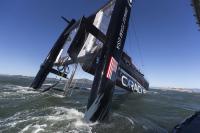 The America’s Cup soap opera continues, with all the twists and turns one might expect and few that are a complete surprise. As in any soap opera, it has its share of betrayals, broken promises, jilted lovers, illicit liaisons and the switching of partners. It remains to be seen whether the soap opera’s plot twists will end up hurting the races.
The America’s Cup soap opera continues, with all the twists and turns one might expect and few that are a complete surprise. As in any soap opera, it has its share of betrayals, broken promises, jilted lovers, illicit liaisons and the switching of partners. It remains to be seen whether the soap opera’s plot twists will end up hurting the races.
Last December it was revealed that the 35th edition of the America’s Cup to be held in 2017 will be sailed in Bermuda. The previous June, it had also been announced that the races would be sailed in 62 foot long foiling catamarans, AC62s. Aside from a few raised eyebrows over the American defender choosing a foreign harbor as the race venue, things seemed to be moving along, more or less. Six teams, including the defender, were scheduled to compete.
You may recall the Norwegian comedy team Ylvis from their viral hit, “What Does the Fox Say?,” which was viewed more than a half billion times on Youtube. One of their more recent music videos, released in September, is on knot tying, specifically, the Trucker’s Hitch. The Trucker’s Hitch also known as a Power Cinch Knot is useful for securing a dinghy to the deck as well as having a number of other uses. Now, thanks to Ylvis, it is also a dance move. While their video is a lot of fun, if you actually want to learn how to tie a trucker’s hitch check out the video from the good folks at Animated Knots by Grog, after the page break.
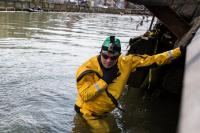
Photo:Kirsten Luce for The New York Times
Christopher Swain, an environmental activist, spent about an hour swimming in New York’s Gowanus Canal earlier this week on Earth Day. He said he made his swim as a “call for an accelerated cleanup of the Canal.” The Gowanus Canal is a 1.8-mile-long waterway connecting Upper New York Bay (the bay in between Brooklyn, Manhattan, New Jersey, and Staten Island) with the formerly industrial interior of Brooklyn. It is also one of North America’s most polluted waterways and has been a “Superfund” site since 2010. In 2013, the Environmental Protection Agency developed a cleanup plan which is expected to cost $506 million and should be completed by 2022. It is unclear how Mr. Swain’s swim will speed up the process.
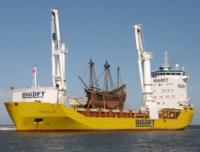 Half Moon, a replica of Henry Hudson’s ship, looks very small sitting on the deck of the heavy-lift ship Traveler, which is carrying the ship to its new berth at the Westfries Museum in Hoorn, in the Netherlands. As heavy lift ships go, the Traveler, at 326 feet long, is one of the smaller ships in the Big Lift fleet, yet still looks very large as compared to the 85 feet long Half Moon. Nevertheless, small as it may have been, the original Half Moon, or Halve Maen in Dutch, was one of the ships that changed the world.
Half Moon, a replica of Henry Hudson’s ship, looks very small sitting on the deck of the heavy-lift ship Traveler, which is carrying the ship to its new berth at the Westfries Museum in Hoorn, in the Netherlands. As heavy lift ships go, the Traveler, at 326 feet long, is one of the smaller ships in the Big Lift fleet, yet still looks very large as compared to the 85 feet long Half Moon. Nevertheless, small as it may have been, the original Half Moon, or Halve Maen in Dutch, was one of the ships that changed the world.
